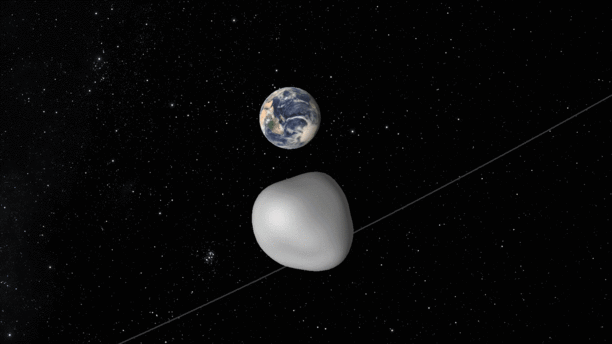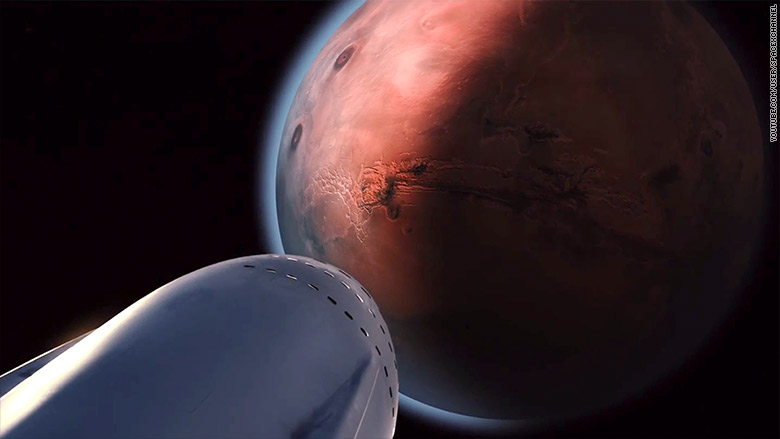Proof of a Parallel Universe? Mysterious 'Cold Spot' Could Mean the Multiverse Actually Exists
Naia Carlos, Nature World News | 19 May 2017
A new study offers new evidence of the multiverse.
(Photo : NASA/Getty Images)
The multiverse is one of the most intriguing theories around, only it's one that has yet to be proven. The theory is that there are an infinite number of universes and ours is only a version of reality; the rest are in a dimension humans can't access (yet).
A new study has offered the best evidence so far of the existence of these parallel universes. According to a report from The Guardian, researchers recently analyzed what's called the "cold spot" that was spotted in the radiation from the formation of the universe over 13 billion years ago.
Blanketing the entire sky is the cosmic microwave background (CMB), which is a relic of the Big Bang that astronomers can observe for a peek at the early stages of the universe, a report from WIRED said. It has a temperature of 2.73 degrees above absolute zero, but there are certain anomalies like the cold spot that extends 1.8 billion light-years across and 0.00015 degrees colder than its surroundings.
The source of the cold spot, first detected in 2004 and again in 2013, is a mystery. Researchers say that it's not likely to have been produced during the birth of the universe, since the best current theory of its formation -- inflation -- would be mathematically challenging to explain otherwise. Meanwhile, the latest study disproves that the cold spot is just an optical illusion.
While it's still possible that it's merely a fluctuation caused by the standard theory of Big Bang, Durham University's Professor Tom Shanks said that there are more "exotic explanations" for the cold spot's existence.
"Perhaps the most exciting of these is that the Cold Spot was caused by a collision between our universe and another bubble universe," Shanks explained to the Royal Astronomical Society. "If further, more detailed, analysis ... proves this to be the case then the Cold Spot might be taken as the first evidence for the multiverse."
Do we live in a multiverse? (Video)
Code:https://www.youtube.com/watch?time_continue=5&v=Rx7erWZ8TjA
 |
 |
|
|||||||||||
 |
 |
||||||||||||
|
|
|
|
|
|
|
||||||||
 |
|
|
|
|
|
 |
|||||||
|
|
|
|
|||||||||||
|
|
|||||||||||||
|
|
|
|
|
|
|
|
|
|
|
|
|
|
|
Results 571 to 580 of 679
-
05-19-2017, 12:15 PM #571Beginner's Guide for Rocket, NFPS and IKS66...
http://iptvtalk.net/showthread.php?2...-you-should-do
Kodi Options for Rocket, NFPS and IKS66...
http://iptvtalk.net/forumdisplay.php?71-Kodi
Check the Announcement Section...
http://iptvtalk.net/forumdisplay.php...-Announcements
-
05-28-2017, 11:52 AM #572A Whole New Jupiter: First Science Results from NASA’s Juno Mission
NASA Release 17-051 \ May 25, 2017

This image shows Jupiter’s south pole, as seen by NASA’s Juno spacecraft from an altitude of 32,000 miles (52,000 kilometers). The oval features are cyclones, up to 600 miles (1,000 kilometers) in diameter. Multiple images taken with the JunoCam instrument on three separate orbits were combined to show all areas in daylight, enhanced color, and stereographic projection.
Credits: NASA/JPL-Caltech/SwRI/MSSS/Betsy Asher Hall/Gervasio Robles
Early science results from NASA’s Juno mission to Jupiter portray the largest planet in our solar system as a complex, gigantic, turbulent world, with Earth-sized polar cyclones, plunging storm systems that travel deep into the heart of the gas giant, and a mammoth, lumpy magnetic field that may indicate it was generated closer to the planet’s surface than previously thought.
“We are excited to share these early discoveries, which help us better understand what makes Jupiter so fascinating,” said Diane Brown, Juno program executive at NASA Headquarters in Washington. "It was a long trip to get to Jupiter, but these first results already demonstrate it was well worth the journey.”
Juno launched on Aug. 5, 2011, entering Jupiter’s orbit on July 4, 2016. The findings from the first data-collection pass, which flew within about 2,600 miles (4,200 kilometers) of Jupiter's swirling cloud tops on Aug. 27, are being published this week in two papers in the journal Science, as well as 44 papers in Geophysical Research Letters.
“We knew, going in, that Jupiter would throw us some curves,” said Scott Bolton, Juno principal investigator from the Southwest Research Institute in San Antonio. “But now that we are here we are finding that Jupiter can throw the heat, as well as knuckleballs and sliders. There is so much going on here that we didn’t expect that we have had to take a step back and begin to rethink of this as a whole new Jupiter.”
Among the findings that challenge assumptions are those provided by Juno’s imager, JunoCam. The images show both of Jupiter's poles are covered in Earth-sized swirling storms that are densely clustered and rubbing together.
“We're puzzled as to how they could be formed, how stable the configuration is, and why Jupiter’s north pole doesn't look like the south pole,” said Bolton. “We're questioning whether this is a dynamic system, and are we seeing just one stage, and over the next year, we're going to watch it disappear, or is this a stable configuration and these storms are circulating around one another?”
Another surprise comes from Juno’s Microwave Radiometer (MWR), which samples the thermal microwave radiation from Jupiter’s atmosphere, from the top of the ammonia clouds to deep within its atmosphere. The MWR data indicates that Jupiter’s iconic belts and zones are mysterious, with the belt near the equator penetrating all the way down, while the belts and zones at other latitudes seem to evolve to other structures. The data suggest the ammonia is quite variable and continues to increase as far down as we can see with MWR, which is a few hundred miles or kilometers.
Prior to the Juno mission, it was known that Jupiter had the most intense magnetic field in the solar system. Measurements of the massive planet’s magnetosphere, from Juno’s magnetometer investigation (MAG), indicate that Jupiter’s magnetic field is even stronger than models expected, and more irregular in shape. MAG data indicates the magnetic field greatly exceeded expectations at 7.766 Gauss, about 10 times stronger than the strongest magnetic field found on Earth.
“Juno is giving us a view of the magnetic field close to Jupiter that we’ve never had before,” said Jack Connerney, Juno deputy principal investigator and the lead for the mission’s magnetic field investigation at NASA's Goddard Space Flight Center in Greenbelt, Maryland. “Already we see that the magnetic field looks lumpy: it is stronger in some places and weaker in others. This uneven distribution suggests that the field might be generated by dynamo action closer to the surface, above the layer of metallic hydrogen. Every flyby we execute gets us closer to determining where and how Jupiter’s dynamo works.”
Juno also is designed to study the polar magnetosphere and the origin of Jupiter's powerful auroras—its northern and southern lights. These auroral emissions are caused by particles that pick up energy, slamming into atmospheric molecules. Juno’s initial observations indicate that the process seems to work differently at Jupiter than at Earth.
Juno is in a polar orbit around Jupiter, and the majority of each orbit is spent well away from the gas giant. But, once every 53 days, its trajectory approaches Jupiter from above its north pole, where it begins a two-hour transit (from pole to pole) flying north to south with its eight science instruments collecting data and its JunoCam public outreach camera snapping pictures. The download of six megabytes of data collected during the transit can take 1.5 days.
“Every 53 days, we go screaming by Jupiter, get doused by a fire hose of Jovian science, and there is always something new,” said Bolton. “On our next flyby on July 11, we will fly directly over one of the most iconic features in the entire solar system -- one that every school kid knows -- Jupiter’s Great Red Spot. If anybody is going to get to the bottom of what is going on below those mammoth swirling crimson cloud tops, it’s Juno and her cloud-piercing science instruments.”
NASA's Jet Propulsion Laboratory in Pasadena, California, manages the Juno mission for NASA. The principal investigator is Scott Bolton of the Southwest Research Institute in San Antonio. The Juno mission is part of the New Frontiers Program managed by NASA's Marshall Space Flight Center in Huntsville, Alabama, for the agency’s Science Mission Directorate. Lockheed Martin Space Systems, in Denver, built the spacecraft.Beginner's Guide for Rocket, NFPS and IKS66...
http://iptvtalk.net/showthread.php?2...-you-should-do
Kodi Options for Rocket, NFPS and IKS66...
http://iptvtalk.net/forumdisplay.php?71-Kodi
Check the Announcement Section...
http://iptvtalk.net/forumdisplay.php...-Announcements
-
07-30-2017, 06:51 PM #573A test of NASA’s asteroid defense system
By Eddie Irizarry and Deborah Byrd in Human World | Space | July 29, 2017
Asteroid 2012 TC4 might give Earth a close shave, or pass more distantly, in October, 2017. Scientists are trying to reacquire the asteroid this summer – find it again in space – to determine its precise orbit.

The Center for Near Earth Object Studies (CNEOS) at NASA’s Jet Propulsion Laboratory in Pasadena, California has had its eye on a small asteroid, designated 2012 TC4, that will pass close to Earth on October 12, 2017. These experts have said that, even though they can’t yet predict exactly how close it’ll come, they’re certain it’ll fly by at a safe distance. That safe distance could be a very close shave, with the space rock passing no closer than 4,200 miles (6,800 km) from our planet. Or it could be a more distant pass, some two-thirds the moon’s distance from Earth. Late in the day on Friday (July 28, 2017), scientists at the University of Arizona (UA) in Tucson, Arizona announced an international collaboration that is utilizing asteroid 2012 TC4 in an exercise to test NASA’s network of observatories and scientists who work with planetary defense.
When we say CNEOS has had its eye on this asteroid, we mean that only figuratively. The calculations on its pass in October, 2017 are based on only seven days of tracking 2012 TC4, shortly after it was discovered in 2012. The Pan-STARRS observatory in Hawaii discovered it on October 5, 2012, and, one week later, the asteroid passed Earth at a distance of only 58,905 miles (94,800 km), or about a quarter of the distance between us and the moon.
Astronomers haven’t seen the asteroid since 2012, because it’s been so distant and so faint. The 2012 observations gave them enough information to put Earth in the clear for the 2017 pass.
However, the lack of further observations hasn’t let scientists precisely define the asteroid’s orbit (although they’re confident there’s no danger of a collision).
The international collaboration described by UA on Friday will help scientists to determine the asteroid’s orbit more precisely. The Lunar and Planetary Laboratory at UA is leading the campaign to reacquire 2012 TC4. In other words, even now, we are not tracking the asteroid; no one has seen it yet on this upcoming approach.
Thus as 2012 TC4 starts to approach Earth this summer, large telescopes will be searching for it, with the goal of re-establishing its precise trajectory. The asteroid should become visible again to large ground-based telescopes in early August, scientists say.
The new observations are expected to help refine knowledge about its orbit, narrowing the uncertainty about how far it will be from Earth at its closest approach in October.Beginner's Guide for Rocket, NFPS and IKS66...
http://iptvtalk.net/showthread.php?2...-you-should-do
Kodi Options for Rocket, NFPS and IKS66...
http://iptvtalk.net/forumdisplay.php?71-Kodi
Check the Announcement Section...
http://iptvtalk.net/forumdisplay.php...-Announcements
-
08-05-2017, 09:08 AM #574
Thanks ilan. Ill be watching out for it.
 I gather darkness to please me...
I gather darkness to please me...
-
08-05-2017, 05:47 PM #575
Let's hope it isn't too close a shave. This has all the trappings of a sci-fi movie.
Beginner's Guide for Rocket, NFPS and IKS66...
http://iptvtalk.net/showthread.php?2...-you-should-do
Kodi Options for Rocket, NFPS and IKS66...
http://iptvtalk.net/forumdisplay.php?71-Kodi
Check the Announcement Section...
http://iptvtalk.net/forumdisplay.php...-Announcements
-
08-05-2017, 05:59 PM #576
So does this mean that approx every 5 years this asteroid will pass Earth ?
Or until it collides with something and gets kicked off course (like the Earth) ?
Where did it come from in the first place ? Who let the dogs out !!
And where the heck was Jupiter in all this ? ... Lapsing on its job I see "The illusion of freedom will continue for as long as it's profitable to continue the illusion. At the point where the illusion becomes too expensive to maintain, they will take down the scenery, move the tables and chairs out of the way, then they will pull back the curtains and you will see the brick wall at the back of the theater."
"The illusion of freedom will continue for as long as it's profitable to continue the illusion. At the point where the illusion becomes too expensive to maintain, they will take down the scenery, move the tables and chairs out of the way, then they will pull back the curtains and you will see the brick wall at the back of the theater."
- Frank Zappa
-
08-05-2017, 09:50 PM #577
Jupiter was busy posing for Juno. Shameless self-promotion!
Beginner's Guide for Rocket, NFPS and IKS66...
http://iptvtalk.net/showthread.php?2...-you-should-do
Kodi Options for Rocket, NFPS and IKS66...
http://iptvtalk.net/forumdisplay.php?71-Kodi
Check the Announcement Section...
http://iptvtalk.net/forumdisplay.php...-Announcements
-
03-01-2018, 01:27 PM #578Scientists detect 'fingerprint' of first light ever in the universe
By Ben Westcott, CNN Updated 4:48 AM ET, Thu March 1, 2018
(CNN) Scientists have detected traces of the earliest light in the universe thought to emanate from the first stars formed after the Big Bang, billions of years ago.
The new report, published in Nature on February 28, said researchers found the "fingerprint" of the universe's first light as background radiation left on hydrogen.
"This is the first time we've seen any signal from this early in the Universe, aside from the afterglow of the Big Bang," Judd Bowman, an astronomer at Arizona State University who led the work, said in a statement. Following the Big Bang, physicists believe there was only darkness in the universe for about 180 million years, a period known by scientists as Cosmic "Dark Ages."

As the universe expanded, the soup of ionized plasma created by the Big Bang slowly began to cool and form neutral hydrogen atoms, say physicists. Eventually these were pulled together by gravity and ignited to form stars.
The new discovery is the closest scientists have ever come to observing that moment of "cosmic dawn."
"It's very exciting to see our baby stars being born," Keith Bannister, astronomer at Australia's Commonwealth Scientific and Industrial Research Organisation (CSIRO), told CNN.
"(Although) we can't see the stars themselves, we're seeing the effect they have on the gas around them."
The discovery was made at a radio telescope in Western Australia, the Murchison Radio-astronomy Observatory, operated by the CSIRO.Last edited by ilan; 03-01-2018 at 03:08 PM. Reason: Added Image from NSF
Beginner's Guide for Rocket, NFPS and IKS66...
http://iptvtalk.net/showthread.php?2...-you-should-do
Kodi Options for Rocket, NFPS and IKS66...
http://iptvtalk.net/forumdisplay.php?71-Kodi
Check the Announcement Section...
http://iptvtalk.net/forumdisplay.php...-Announcements
-
03-13-2018, 12:30 PM #579Elon Musk: Mars rocket will fly 'short flights' next year

Elon Musk issued yet another incredibly ambitious timeline.
During a Q&A at the SXSW festival on Sunday, Musk said SpaceX will be ready to fly its Mars rocket in 2019.
"We are building the first ship, or interplanetary ship, right now," Musk said. "And we'll probably be able to do short flights, short up and down flights, during the first half of next year.
"Musk said last year that his Mas rocket, called BFR or Big Falcon Rocket, could one day fly people from city to city on Earth in incredibly short time spans, touting that it would take 30 minutes to hop from New York to Shanghai.
He said at the time that he hopes a BFR will land on Mars in 2022, and the first missions will send cargo. Eventually, the rocket will host convoys of people and their belongings. The ultimate goal is to establish a self-sustaining colony on the Red Planet.Beginner's Guide for Rocket, NFPS and IKS66...
http://iptvtalk.net/showthread.php?2...-you-should-do
Kodi Options for Rocket, NFPS and IKS66...
http://iptvtalk.net/forumdisplay.php?71-Kodi
Check the Announcement Section...
http://iptvtalk.net/forumdisplay.php...-Announcements
-
03-13-2018, 12:54 PM #580
Mr Musk is awesome. We're gonna make some big gains in space exploration thanks to him.
 I gather darkness to please me...
I gather darkness to please me...
Similar Threads
-
RCU model pics
By crazed 9.6 in forum BuzzTV RemotesReplies: 25Last Post: 01-05-2024, 10:41 PM -
BuzzTV e1 - pics
By Ryu in forum BuzzTV EssentialsReplies: 0Last Post: 02-01-2021, 01:06 AM -
Zx Pics
By Capt.Kangaroo in forum Formuler ZxReplies: 17Last Post: 09-21-2018, 02:38 PM -
This is cool pics
By Marley in forum Chit Chat LoungeReplies: 0Last Post: 03-06-2018, 06:41 PM -
Space Pics v.3
By Capt.Kangaroo in forum Deep SpaceReplies: 527Last Post: 05-25-2016, 02:09 PM








 Reply With Quote
Reply With Quote


